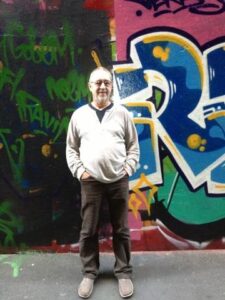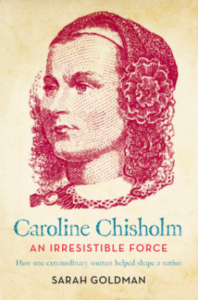by Bill Holloway
 Caroline Chisholm (1808-1877) is one of our more interesting independent women. She married, but only on the condition she remain independent, and her husband ended up working in her cause rather than she in his.
Caroline Chisholm (1808-1877) is one of our more interesting independent women. She married, but only on the condition she remain independent, and her husband ended up working in her cause rather than she in his.
By and large, Australia’s iconic Independent Women up to the 1950’s were determinedly single; women like Catherine Helen Spence or Miles Franklin who knew they could not function autonomously while also shouldering the burdens of wifedom and motherhood. Very few had the luxury, as Henry Handel Richardson famously did, of being supported within a childless marriage as she was by John Robertson.
Some, for example Daisy Bates, abandoned husbands – and in her case, a son – to pursue independent careers; and at least one, Ernestine Hill, was both independent and successful while raising a child out of wedlock.
But I can think of only one who had a husband who followed and supported her when she took the lead, pioneering social worker, Caroline Chisholm.
 My sources for this account of her life are Mary Hoban, Fifty-One Pieces of Wedding Cake (1973); and Sarah Goldman, Caroline Chisholm (2017). I’m not sure what their sources were. One mentions a diary that was lost. There are earlier biographies. Both Hoban and Goldman resort to flights of imagination. I can only imagine there must be a trove of letters home to Caroline’s mother and siblings, as well as published letters and pamphlets.
My sources for this account of her life are Mary Hoban, Fifty-One Pieces of Wedding Cake (1973); and Sarah Goldman, Caroline Chisholm (2017). I’m not sure what their sources were. One mentions a diary that was lost. There are earlier biographies. Both Hoban and Goldman resort to flights of imagination. I can only imagine there must be a trove of letters home to Caroline’s mother and siblings, as well as published letters and pamphlets.
Caroline Chisholm was born in Northampton, England. Her father, William Jones, by then 64, started out as a farm labourer, becoming a prosperous property owner and ‘hog jobber’. He died when she was six, leaving Caroline an investment property with substantial rentals. Caroline’s mother, with a number of other children to support, promptly offloaded Caroline onto another Northampton woman and then to boarding school where she seems to have obtained a good education. Later, Caroline named possibly the same Northampton woman, Sarah Laws, as her mother in the 1851 census.
Caroline early decided on a career in charity. In 1829 she turned 21 and became mistress of her own fortune, but of course only for so long as she remained unmarried. A year later, thirty year old Lieutenant Archibald Chisholm, a Scotsman and a Catholic, returning home on furlough from ten years with the East India Company, met Caroline in Northampton and asked for her hand in marriage. She initially refused, only relenting when he acceded to the condition that she retain the freedom to pursue her own objectives. Caroline, brought up Protestant, then converted to Catholicism.
In India, the Chisholm’s lived in Madras, in Fort St George, a mile square compound, and Caroline, with a servant for every need, lived an easy life socialising with the other wives. When this palled Caroline began a school ‘for the daughters of European soldiers’. It is a measure of Chisholm’s devotion to his wife that when she suggested the school would be better outside the Fort, and despite already being an outsider as a Catholic, he gave her his full support and they moved into premises in Black Town, the mixed-race quarter.
After 5 years the school was a success, and Caroline was the mother of 2 sons, but Archibald, now Captain Chisholm, was due again for furlough. England was cold and expensive and it was decided to give New Holland a try. In March, 1838 they sailed for Sydney, and when Chisholm returned to India in 1840, Caroline stayed on.
The Chisholms had taken a house at Windsor (where they had a third son), but on her visits to Sydney Caroline became aware of the problem of young women brought out from England and Ireland unable to find positions. She began in an informal way taking girls into her home and having her housekeeper train them up for domestic service and then finding them employment. “At one time she had ten living at the house, but housemaids and nursemaids were always in demand.”
By 1841 transportation (of convicts) was coming to an end and the old Immigration Barracks were standing empty. Caroline began campaigning to have the Barracks used for women brought out under the bounty system, who were until then accommodated in tents and provided with minimal sustenance if they couldn’t find work. She also began looking into the imbalance between unemployment in Sydney and labour shortages in the country.
Mrs Chisholm became a familiar figure on the wharves in Sydney, meeting every ship, finding positions for immigrant women and sheltering many of them in her home. In 1841 she established the Female Immigrants’ Home housing up to 96 women and was soon overwhelmingly successful in assisting immigrants to find work in rural NSW, making many trips herself and establishing employment agencies in a dozen centres.
Especially in the early days, the Lone Hand and Independent Woman legends often merged. Here Goldman describes Caroline’s trips out into western NSW:
… travelling with the girls on the wagons or, later, riding her own horse, Captain. Her expeditions went “as far as 300 miles into the far interior, sometimes sleeping at the stations of wealthy settlers, sometimes in the huts of poor emigrants or prisoners; sometimes camping out in the bush, teaching the timid awkward peasantry of England, Scotland and Ireland, Protestant and Roman Catholics, Orangemen and Repealers, how to “bush” it.”
By 1845 when Capt Chisholm retired from service in India, Caroline was well known and highly regarded, and her opinion was sought by – and more often pressed on – the fledgling NSW Legislative Council.
In 1846 the Chisholms returned to England, setting up base in the poorer part of London, and Caroline began advocating for and organising female and family migration to Australia from Britain and Ireland (then in the grip of the Great Famine). There she met Dickens and elements of her survey appeared in the first issue of his magazine Household Words. He was later to satirise her unfairly as Mrs Jellyby in Bleak House. Her establishment of the Family Colonization Loan Society in 1850, and being only the second woman ever to give evidence to a committee of the House of Lords, made her one of the best known people in Great Britain.
The Society chartered and, later had constructed purpose-built ships, including the Caroline Chisholm which was unfortunately commandeered for troop transport to the Crimean War. Archibald was despatched first to Adelaide, then to Melbourne, where he was subsequently joined by Caroline, to act as the Society’s agent. The Chisholms settled in Victoria, in Melbourne and then Kyneton, but the wave of immigration associated with the gold rushes of the 1850s meant that her work was no longer of such importance.
She turned her attention to persuading the government to establish ‘shelter sheds’, accommodation for families walking between Melbourne and the Castlemaine/Bendigo gold fields, and continued to advocate for an Australian ‘yeomanry’ – family based farms to replace the huge runs taken up by squatters whose employees were mostly single men.
Despite her Catholicism, Caroline Chisholm both advocated and practiced multi-culturalism. Attacked by the Protestant preacher John Dunmore Lang for bringing out Irish Catholic girls, Caroline retorted, “I have lived happily amongst pagans and heathens, Mahometans and Hindoos – they never molested me at my devotions, nor did I insult them at theirs; and am I not to enjoy the same privilege in New South Wales?” [reported in Sydney Morning Herald, 20 March 1846]. Later, in Victoria, Chisholm was to speak up in the same way for the largely reviled Chinese (see next week’s post).
In straining to uncover historical women heroines we sometimes find they are given more prominence now than they were then. The reverse is true of Caroline Chisholm, as it is of many women authors, whose considerable reputations and influence at the time have not been brought forward by (male) historians. When you think about it, it is nonsensical that school students once learned more about the failures of Burke & Wills and Ludwig Leichardt, say, than they did (and probably do) about about the successes of Caroline Chisholm, Mary McKillop or Catherine Helen Spence.
.
Caroline Chisholm biographies and references:
Eneas Mackenzie, Memoirs of Mrs Caroline Chisholm (London, 1852) Project Gutenberg Australia
Margaret Kiddle, Caroline Chisholm (1950)
Mary Hoban, Fifty-One Pieces of Wedding Cake (1973)
John Moran ed., Radical in Bonnet and Shawl: Four Political Lectures by Caroline Chisholm. (Australia: Preferential Publications, 1994 and 1991)
Rod Stinson, Unfeigned Love: Historical Accounts of Caroline Chisholm and Her Work, Yorkcross, Sydney, 2008
Carole Walker, A Saviour of Living Cargoes – The Life and Work of Caroline Chisholm, (first published in Australia in 2009 by Australian Scholarly Publishing; republished in Australia in 2011 by Connor Court Publishing; UK edition published by Wolds Publishing, 2010)
Sarah Goldman, Caroline Chisholm: An Irresistible Force, How one extraordinary woman helped shape a nation, Harper Collins, Sydney, 2017
see also the website http://mrschisholm.com/
Bill Holloway, the author of this review, blogs at The Australian Legend. He is an old white guy the subject of whose (very) mature age M.Litt thesis was ‘The Independent Woman in Australian Literature’.






Thanks, Bill. A fascinating insight into Chisholm’s life. What a legend she was!
She was a legend, or should be. We remember her but she’s hardly celebrated.
Really enjoyed this too Bill. Sorry for the delay. My Californian friend arrived the day before this posted, and has just left this morning. I didn’t have a lot of time for reading blog posts.
She really was something, wasn’t she?